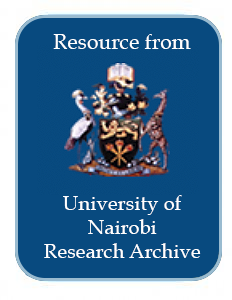Location
Our Vision is to be a world-class university committed to scholarly excellence.
Our Mission is to provide quality university education and training and to embody the aspirations of the Kenyan people and the global community through creation, preservation, integration, transmission and utilization of knowledge.
Core Values
In order to realize the above vision and mission, certain shared values shall be nurtured. There is great need for the University to be guided by the right values derived from the virtues and moral standards of the Kenyan and wider society.
Core Functions
Teaching and Learning: The university offers innovative , relevant and market driven academic programmes , both at undergraduate and postgraduate levels with inbuilt quality control systems the university also provides an environment and policy framework for undertaking high quality and relevant research
Members:
Resources
Displaying 156 - 160 of 298Linkages between land-use, land degradation and poverty in semi-arid rangelands of Kenya: the case of Baringo District
The study discusses land-degradation in pastoral communities and depicts land-use system and associated human and livestock population pressure as the major determinant of vegetation cover, surface run-off, soil erosion, and species richness. The study recommends use of enclosures to reverse range degradation, and diversification of pastoral economies to reduce poverty and relieve pressure on land as the primary source of livelihood in the semi-arid rangelands of Kenya
Trouble in Eden: How and Why Unresolved Land Issues Landed 'Peaceful Kenya'in Trouble in 2008
This article looks at the role of land and grievances thereto in the post-election violence experienced in Kenya in late 2007 and early 2008. It argues that the failure of post-colonial governments to craft a cohesive and inclusive national agenda for development has resulted in a fragmented populace. This fragmentation militates against a national ethic as the citizenry congregate around their ethnic groupings as a source of security and guaranteed access to resources such as land.
Performance Evaluation of Land Administration Systems in Kenya
The performance of any organization can be improved through constant evaluation which helps organizations mirror themselves against acceptable benchmarks, Land administration institutions are no exception. However. most of the land administration systems in LOCs are over-centralized and inflexible in regulatory and legal frameworks and they are rarely evaluated. This paper uses documented key oettormence indicators of effectiveness. efficiency and quality in an attempt to evaluate Kenya's land
Agricultural Land Management for Sustainable Development in Rural Kenya
Land is one of the most important naturaE resources for the creation of wealth in many societies. Its ownership and control brings economic power, which in turn, is often the basis for social and polifical power Unlike other factors of production such as labour and capilal, land is in fixed supply. Of the total land area of Kenya of 56.9 million hectares, more than 90 percent is agricultural land. Over 80 percent of this land is categorized as Arid and Semiarid land where about 25 percent of the total population resides and over 50 percent of the total livestock is produced.
Rahani: A Unique Commercial Land Tenure Arrangement Amongst the Digo of Kenya's Coast
Land ownership, distribution, utilisation and exchange amongst the Digo people of Kenya's lower Coast is done through both formal systems and informal arrangements, 'Rahani'is an informal arrangement that allows landowners to rent out their excess or idle land at a price over an uncertain duration. Using data from several classes of respondents, this paper found that landowners practices 'rahani'to get quick money to attend to immediate domestic, personal and welfare problems. The negative impacts of 'rahani' include the possibility of loss and misuse of the rented land.






